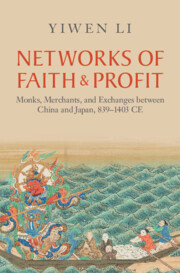
While Muslim traders from the Arabic world and Jewish traders in the Mediterranean have enjoyed a long-established reputation for business acumen, Buddhist traders maintain a rather obscure position in histories of commerce. This may be because ancient Indian Buddhist scriptures hold that trading constituted misconduct on the part of monks, and trading for profit was an even graver offense. But in reality, Buddhist monks were actively seeking opportunities in overseas trade to obtain sacred scriptures, ritual objects, and money. After all, a monastery’s prestige was closely related to its possession of precious sutras and effective ritual objects, and the building and maintenance of the monastic compound was costly, too.
Between the seventh and early ninth centuries, when Japan was sending tribute delegations to China on a relatively regular basis, monks were always part of the around 600-people embassy. The Buddhist communities in Japan then viewed China as an important source for providing more advanced teachings and ritual knowledge. When the diplomatic relationship between China and Japan grounded to a halt, the motivations for monks to travel were still strong. They boarded merchant ships to cross the sea, and monks and merchants meanwhile formed a network that tied the continent and the archipelago even closer than the previous tribute era.
My recent book, Networks of Faith and Profit, focuses on the six centuries when Japan stopped sending tributes to China, and faith-inspired monks and profit-driven sea merchants became the key players in Sino-Japanese exchanges. The exchanges were by nature private, which prompted us to examine nonofficial records. The main types of sources that I have used to write the book include pilgrim monks’ diaries, correspondence between monks and sea merchants, monastic histories, and archaeological discoveries. The nonofficial records reveal a vivid East Asian maritime world.
For example, Chapter 5 of the book discusses a case that tells the actual working dynamics of the religio-commercial network formed by monks and merchants. That case is about a transaction of lumber that occurred between a prestigious Chinese monastery, Jingshan, in the Southern Song capital of Hangzhou, and a newly established Japanese monastery, Jōtenji, in the port of Hakata. In the 1240s, Jingshan was damaged by a fire and needed lumber for the reconstruction. The abbot of Jōtenji once studied at the Jingshan monastery and thus had a good and strong connection there. Meanwhile, a major patron of the Jōtenji was a Chinese sea merchant originally from Hangzhou. Therefore, with the help of the Chinese merchant, Jōtenji sent 1,000 wooden planks to Hangzhou in three ships, but one ship accidentally landed at a port that could not process overseas goods. The ship was detained for more than a year, so the merchants appointed by the Jōtenji monastery had to seek help from the Chinese Jingshan monastery. The fiscal advisor of the monastery took advantage of the religious resources that Jingshan possessed, borrowed money from Jingshan’s patrons, and used the money to bribe the Chinese officials in charge to eventually get the merchant’s ship back.
Today, we can recover this transaction in great detail because a set of letters from the monks in Hangzhou sent to Japan have been preserved. Those letters were considered valuable calligraphy works written by famous Chinese Buddhist masters, and works like those were used as decorations for Japanese tea rooms in the premodern and early modern era. Therefore, the sources have been carefully preserved not as historical records and, to some extent, by accident. It is through those scattered and nonofficial records we can see the real maritime world, where ships didn’t always land at their targeted ports, and corrupted officials may cause unexpected problems or become a help. We can also see that in the real world, people’s connections really mattered, and the religio-commercial network was crucial for both the merchants and the monks.
Networks of Faith and Profit includes other telling episodes that offer a fresh image of monks and merchants. A set of letters from the ninth century recorded a Chinese sea merchant family sent a young member to serve as an attendant to a monk in Japan, in the hope that the monk later could assist them with smuggling goods. A 14th-century shipwreck retrieved from South Korean waters contained a tremendous amount of cargo-more than 20,000 Chinese ceramics and 28 tons of bronze coins, among many others. The wooden tags attached to the shipment indicate that a famous monastery in Kyoto collaborated with sea merchants in that trade voyage and owned a large portion of the goods.
The networks established by the Buddhist monks and sea merchants during the tribute hiatus profoundly impacted the Sino-Japanese relationship in the ensuing centuries. When Japan resumed dispatching tribute envoys to China in the early sixteenth century, eminent monks took up primary positions in the delegations. Not long after China and Japan resumed their diplomatic relationship, Columbus arrived in the Americas, and a new global trade network began to take shape. The new global network, with more regions in direct contact with each other, owes much to previous systems. My book shows that official diplomatic relationships were not always necessary for two countries to maintain contacts with each other. Other forms of communication-such as religious and commercial exchanges-often influenced and modified official tribute relations. As the book seeks to help demonstrate, the real and enduring networks that connected different regions rarely formed because policymakers planned them; they took shape because people desired contact with each other-whether pilgrim monks or itinerant merchants, and whether they were traveling for faith or for profit.
Remains of the Sinan shipwreck on display at the National Research Institute of Maritime Cultural Heritage, Mokpo, South Korea. Courtesy of the National Research Institute of Maritime Cultural Heritage.

Networks of Faith and
Profit by Yiwen Li
Latest Comments
Have your say!